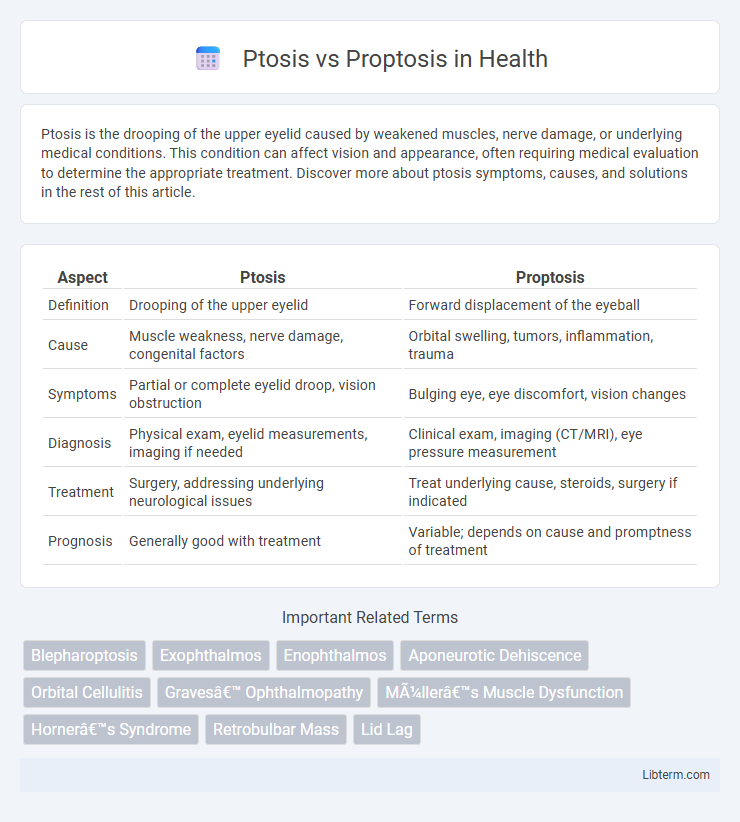Ptosis is the drooping of the upper eyelid caused by weakened muscles, nerve damage, or underlying medical conditions. This condition can affect vision and appearance, often requiring medical evaluation to determine the appropriate treatment. Discover more about ptosis symptoms, causes, and solutions in the rest of this article.
Table of Comparison
| Aspect | Ptosis | Proptosis |
|---|---|---|
| Definition | Drooping of the upper eyelid | Forward displacement of the eyeball |
| Cause | Muscle weakness, nerve damage, congenital factors | Orbital swelling, tumors, inflammation, trauma |
| Symptoms | Partial or complete eyelid droop, vision obstruction | Bulging eye, eye discomfort, vision changes |
| Diagnosis | Physical exam, eyelid measurements, imaging if needed | Clinical exam, imaging (CT/MRI), eye pressure measurement |
| Treatment | Surgery, addressing underlying neurological issues | Treat underlying cause, steroids, surgery if indicated |
| Prognosis | Generally good with treatment | Variable; depends on cause and promptness of treatment |
Introduction to Ptosis and Proptosis
Ptosis is the drooping or falling of the upper eyelid, often caused by muscle weakness, nerve damage, or congenital defects, affecting both vision and appearance. Proptosis refers to the abnormal forward displacement or bulging of the eye, commonly resulting from conditions like thyroid eye disease, tumors, or inflammation. Differentiating ptosis from proptosis is crucial for accurate diagnosis and targeted treatment in ophthalmology and neurology.
Defining Ptosis: Causes and Symptoms
Ptosis is characterized by the drooping of the upper eyelid due to weakness or paralysis of the levator muscle or dysfunction of the oculomotor nerve. Common causes include congenital defects, myasthenia gravis, third cranial nerve palsy, or age-related muscle degeneration. Symptoms often involve reduced visual field, eye fatigue, and asymmetric eyelid appearance.
Understanding Proptosis: Causes and Signs
Proptosis, characterized by the abnormal protrusion of the eyeball, is commonly caused by thyroid eye disease, orbital tumors, or inflammation such as orbital cellulitis. Key signs include noticeable eye bulging, eyelid retraction, and impaired eye movement, often accompanied by dryness or vision changes. Accurate diagnosis through imaging studies like CT or MRI is crucial for determining the underlying cause and guiding effective treatment.
Key Differences Between Ptosis and Proptosis
Ptosis is characterized by the drooping of the upper eyelid due to muscle weakness or nerve damage, whereas proptosis involves the abnormal protrusion of the eyeball often caused by orbital tumors, inflammation, or thyroid eye disease. Ptosis primarily affects eyelid position and vision obstruction, while proptosis results in noticeable eye bulging and may cause exposure-related complications. Understanding these differences is crucial for accurate diagnosis and effective treatment of underlying conditions impacting eyelid function and eye positioning.
Common Risk Factors for Ptosis and Proptosis
Common risk factors for ptosis include aging, nerve damage, trauma, and underlying neurological conditions such as myasthenia gravis, while proptosis is often associated with thyroid eye disease, orbital tumors, inflammation, or vascular abnormalities. Both conditions may arise due to congenital defects or systemic diseases affecting the orbital muscles and tissues. Early diagnosis and treatment of these risk factors are critical to prevent vision impairment and orbital complications.
Diagnostic Methods for Ptosis vs Proptosis
Diagnostic methods for ptosis primarily involve clinical examination including measurement of the margin-reflex distance, levator function testing, and assessing eyelid position relative to the pupil. Imaging studies such as MRI or CT scans may be ordered to determine underlying neurological or muscular causes. For proptosis, diagnostic evaluation includes Hertel exophthalmometry to quantify globe displacement, orbital ultrasound, CT or MRI to assess for orbital masses, inflammation, or thyroid eye disease, alongside thyroid function tests to evaluate systemic involvement.
Potential Complications and Prognosis
Ptosis, characterized by drooping of the upper eyelid, can lead to vision obstruction and amblyopia if untreated, with prognosis improving through surgical correction or treatment of underlying causes. Proptosis involves abnormal forward displacement of the eyeball, increasing risks of corneal exposure, optic nerve compression, and vision loss, often requiring urgent intervention to prevent permanent damage. Early diagnosis and management of both conditions are critical to minimizing complications and optimizing long-term visual outcomes.
Treatment Options for Ptosis
Treatment options for ptosis primarily include surgical procedures such as levator resection or frontalis sling surgery, aimed at elevating the drooping eyelid to restore proper vision and appearance. Non-surgical methods like ptosis crutches or eyelid tape provide temporary relief but do not address underlying muscle weakness. In cases caused by underlying neurological or muscular conditions, treatment of the root cause alongside symptomatic eyelid correction is essential for optimal outcomes.
Management and Treatment of Proptosis
Management of proptosis primarily depends on the underlying cause, ranging from orbital infections and inflammation to tumors and thyroid eye disease. Treatment often involves corticosteroids to reduce inflammation, antibiotics for infections, or surgical intervention to relieve orbital pressure and restore eye function. In thyroid eye disease, therapies such as orbital decompression surgery and immunosuppressive drugs are commonly utilized to manage symptoms and prevent vision loss.
Prevention Strategies and Patient Outlook
Ptosis prevention involves managing underlying causes such as nerve damage, aging, or trauma through regular eye check-ups and protective measures against injury. Proptosis prevention focuses on treating thyroid eye disease early and monitoring for orbital infections or tumors to avoid severe complications. Patient outlook varies; ptosis often improves with surgical correction or therapy, while proptosis prognosis depends on the cause and effectiveness of treating the underlying condition.
Ptosis Infographic

 libterm.com
libterm.com